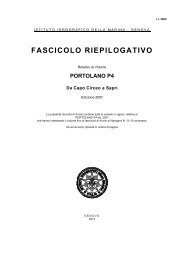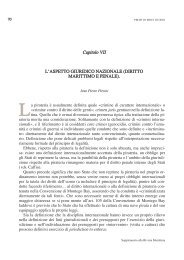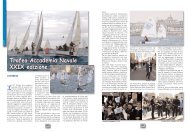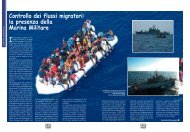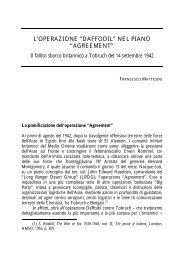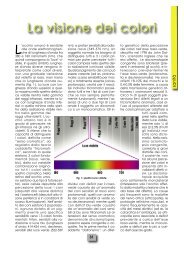143 Anno XVIII - 2008 - Marina Militare
143 Anno XVIII - 2008 - Marina Militare
143 Anno XVIII - 2008 - Marina Militare
You also want an ePaper? Increase the reach of your titles
YUMPU automatically turns print PDFs into web optimized ePapers that Google loves.
3<br />
In 2004, the pace of the structural transformation<br />
initiated in the mid-1990s was further incremented<br />
in the revised version of the NDPO. The new<br />
document, which was approved in December as<br />
NDPG, 52 sought to address Japan’s responses<br />
to the systemic changes brought about by the<br />
9/11 attacks to the United States, North Korea’s<br />
political brinkmanship and nuclear policies, and<br />
China’s double-digit investments in military<br />
modernisation. Compared to its predecessor,<br />
the NDPG emphasised more the existence<br />
of conventional sources of military concern<br />
in the region. Nonetheless, it maintained an<br />
overall balanced approach calling for a military<br />
capable of protecting the country’s territory,<br />
whilst enhancing the nation’s international<br />
status and responsibilities. As a result, the<br />
Japanese military needed to continue its path<br />
from a ‘deterrent effect-oriented’ to a ‘response<br />
capability-oriented’ posture, in order to become<br />
a fully ‘multi-functional flexible defence force’<br />
(MFFDF). 53 The JSDF were to complete the<br />
recalibration of their capabilities to maximise<br />
the prevention or the emergence of threats to the<br />
nation and in case of emergencies, to determine<br />
‘where and how’ to employ of the country’s<br />
military might ‘to maximum effect’. 54 In March<br />
2006, the upgrading of the Joint Staff Office<br />
(JSO) as the coordinating body for operations<br />
like BMD, defence of off-shore islands and<br />
disaster relief, set a new milestone in that<br />
direction. 55<br />
For the JMSDF, the new national doctrine<br />
rewarded the ongoing transformation from a<br />
Cold war ‘sea denial’ force to one engaged at<br />
various degrees in defence against maritime<br />
power projection exploiting sea control (to<br />
defend Japan’s maritime space), expeditionary<br />
capabilities (to contribute to international<br />
security) and ‘good order at sea’ (to contribute<br />
to the safety of maritime activities). 56 In<br />
his official instructions, CMS Admiral Furusho<br />
Koichi (2003-2005) formalised the navy’s<br />
evolving characteristics introducing the concept<br />
of ‘flexibility’ 57 as one of the core tenets of the<br />
navy’s own doctrine. Each task had not to be<br />
blindly carried out along pre-established lines<br />
or plans as was the case during the Cold War;<br />
rather, from the commanders deployed at sea<br />
to the strategic planners in Tokyo, all service<br />
members had to learn to diversify their responses<br />
to meet ‘the unexpected’. 58 The fleet also was to<br />
be reorganised, with the basic tactical formation<br />
shifting from the ASW flotilla (7 DDs + 1<br />
DDH) to the Escort Division (3 DDs + 1 DDH,<br />
or 1 DDG). Compared to the 1995 NDPO, the<br />
relative slowdown of the force downsizing<br />
penned by the NDPG, equal to about 9% of<br />
its surface fleet (from approx. 50 to 47 units)<br />
and a little less than 12% of the air arm (from<br />
approx. 170 to approx. 150 aircraft), partly<br />
gauged such a diversification and widening of<br />
the navy’s commitments. 59 The JMSDF had to<br />
ready itself to deal with conventional threat<br />
(e.g. limited missile attack, illegal occupation<br />
of parts of the country, violation of territorial<br />
air and maritime space) as well as more multinational<br />
commitments.<br />
The increase of naval activities in Japan’s<br />
surrounding maritime milieu made the JMSDF<br />
of the new century as strategically important as<br />
ever in the past. Already in 2001, CMS Admiral<br />
Ishikawa Toru (2001-2003) had eloquently<br />
pointed out that ‘for the JMSDF, the dawn of the<br />
21 st century paved the way to an “era of [hard]<br />
work”. 60 In one step, learning the lessons of the<br />
77-year long history of the IJN, the JMSDF has<br />
passed from a period of “infancy” 61 to one of<br />
“maturity”’. 62 The 2004 NDPG had indirectly<br />
taken note of the Admiral’s words expanding<br />
the undertaking of the JMSDF. In accordance<br />
with the tradition developed in the Cold War, the<br />
leaders of the force responded to the challenge<br />
by opting for a balanced force which could use<br />
the versatility of its assets to maintain at the<br />
same time an effective defensive system against<br />
the ambitions of regional competitors and the<br />
necessary lifting capability to comply to the<br />
expeditionary nature of the nation’s growing<br />
international commitment.<br />
conclusIons<br />
At a more close scrutiny, the history of Japan’s<br />
post-war defence and naval policy strongly<br />
suggests that it is misleading to categorise<br />
the recent transformation of the archipelago’s<br />
military posture as one eyeing power projection<br />
capabilities. Since the second half of the 1970s,<br />
the JMSDF has constantly endeavoured to<br />
improve the quality of the platforms of its<br />
fleet and the basic rationale underpinning its<br />
procurement policies was one dominated by<br />
issues of sea lanes defence (up to a 1,000 nautical<br />
miles form Japanese shores in the 1980s) and of<br />
sea control within the national maritime space.<br />
More recently, the modernisation process and<br />
naval activities of the People’s Liberation<br />
Army Navy (PLAN) and North Korea’s missile<br />
capabilities made of the potential applications in<br />
fleet air defence and BMD of the latest Kongo<br />
(DDG-173) and Atago (DDG-177) class of<br />
Aegis-equipped destroyers a clear example of<br />
the JMSDF’s state-of-the-art defensive means<br />
to maintain sea control in the waters of the<br />
western Pacific. Against this backdrop, with the<br />
new Hyuga class of helicopter carriers, which<br />
can carry a combination of up to 10 SH-60K<br />
Helicopters and MCH-101 for ASW and Search<br />
and Rescue and is equipped with one 16-cell<br />
Mk41 vertical launch system – VLS -, 2 Phalanx<br />
multi-barrel CIWS and Aegis-type air defence



